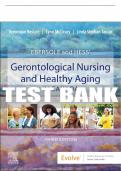Test Bank For Ebersole and Hess' Gerontological Nursing & Healthy Aging in Canada, 3e Chapter 01: Introduction to Healthy Aging Chapter 01: Introduction to Healthy Aging MULTIPLE CHOICE 1. A man is terminally ill with end -stage prostate cancer. What is the best statement about this man’s wellness? a. Wellness is not possible, because the patient uses medication to assist in management of his medical care. b. Wellness is unfortunately not a real option for the patient. c. Wellness is the same thing as faith healing, and if the patient were more recept ive, he could be back at work in a few weeks. d. Nursing interventions can help empower a patient to achieve a higher level of wellness. ANS: D Feedback A Incorrect. An individual can achieve wellness even if using medications. B Incorrect. All persons, regardless of age or life –health situation, can be helped to achieve a higher level of wellness. C Incorrect. Biomedical approaches and other treatments and techniques are used to achieve realistic improvements in wellness. D Correct. A nurse can foster wellness at all levels of the needs hierarchy. PTS: 1 DIF: Application OBJ: 2 TOP: NCLEX: Health Promotion and Maintenance 2. In differentiating between health and wellness in health care, which of the following statements is true? a. Health is a broad term encompassing attitudes and behaviours. b. The concept of wellness was rarely or never considered by previous generations. c. Wellness and self-actualization develop sim ultaneously through learning and compromise. d. It is impossible to have wellness when one’s health is compromised. ANS: A Feedback A Correct. Holistically, health includes wellness, which involves one’s whole being. B Incorrect. Throughout history, basic self -care requirements have been recognized. C Incorrect. As basic needs are met, higher level needs can be satisfied in turn, with ever-deepening richness to life. 1 Test Bank For Ebersole and Hess' Gerontological Nursing & Healthy Aging in Canada, 3e Chapter 01: Introduction to Healthy Aging D Incorrect. Even with chronic illness, with multiple disabilities, or in dying, movement toward higher wellness is possible. PTS: 1 DIF: Comprehension OBJ: 2 TOP: NCLEX: Health Promotion and Maintenance 3. Which province or territory is predicted to h ave the fastest growing older -person population in Canada between the years 2006 and 2031? a. Ontario b. British Columbia c. Yukon d. Newfoundland ANS: C Feedback A Incorrect. As shown in Figure 1 -1 in your text, the older -person population of Ontario does not rise as rapidly as the older -person population of Yukon between 2006 and 2031. B Incorrect. As shown in Figure 1 -1 in your text, the older -person population of British Columbia does not rise as rapidly as the older -person population of Yukon between 2006 and 2031. C Correct. As shown in Figure 1 -1 in your text, the older -person population of Yukon rises faster than any of the other provinces and territories between 2006 and 2031. D Incorrect. As shown in Figure 1 -1 in your text, the older -person population of Newfoundland does not rise as rapidly as the older -person population of Yuko n between 2006 and 2031. PTS: 1 DIF: Knowledge OBJ: 3 TOP: NCLEX: Health Promotion and Maintenance 4. Historical influences that have shaped the lives of the majority of the middle -old in Canada today include which of the following? a. Influenza epidemic of 1918 b. Immigration from Communist Europe c. Child-rearing during the Depression d. Post-World War II effects ANS: D Feedback A Incorrect. A person who survived the influenza epidemic would be at least 93 years old in 2011 and therefore be considered old -old, or centenarian. B Incorrect. Those who are middle -old in 2011 were born between 1920 and 1930, before Communism swept Europe. 2 Test Bank For Ebersole and Hess' Gerontological Nursing & Healthy Aging in Canada, 3e Chapter 01: Introduction to Healthy Aging C Incorrect. Most of those who are middle -old in 2011 had not reached childbearing age by the end of the Depression. D Correct. Those who are middle -old in 2011 were in their teens and twenties during the war; in particular, the men were very likely to have fought in it. PTS: 1 DIF: Comprehension OBJ: 3 TOP: NCLEX: Health Promotion and Maintenance 5. A nurse prepares for the arrival of older persons evacuated from a forest fire in northern Manitoba to a shelter for short -term care. Which of the following is the priority nursing intervention? a. Demonstrate that the staff is prepared to meet their needs. b. Use individual medical records to develop a medication plan. c. Help older persons to display family photos and memorabilia. d. Help older persons to teach one another a new skill in the she lter. ANS: B Feedback A Incorrect. Providing safety and security from the fire is evident and implied, as the older persons have been evacuated from danger. The priority nursing intervention is caring for any health concerns; e.g., medication or treatments that were left behind. B Correct. The nurse prepares for short -term care by prioritizing the needs of the older persons, and this intervention helps to maintain the therapeutic plan, thereby addressing the need for physiological integrity. Furthermore, the nurse maintains continuity of care by preparing a medication schedule to prevent missed doses of medication. C Incorrect. In emergency conditions, the nurse provides basic care relating to safety, security, and physical well -being. Maintaining a sense of belonging is important, but not in emergency conditions. D Incorrect. A state of emergency is not the time to develop self -esteem because meeting safety, security, and physical needs is more important. PTS: 1 DIF: Analysis OBJ: 4 TOP: NCLEX: Safe and Effective Care Environme nt 6. According to researchers, which characteristic will most centenarians share in the future? a. Being female b. Having dementia c. Being malnourished d. Being wheelchair-bound ANS: A 3





